Sailing into the light of a healthier and more humane?planet
The tall ship, Tecla, a Dutch North Sea sailing herring dragger built in 1915, was tied by three heavy hawser lines to the ferry quay in Ullapool, Northwest Scotland, a town of white-washed buildings packed together for the herring fishery. Most of us had arrived the evening before and we were ready to sail except for obtaining one more official document. The health certificate is not very important to European nations but is required to land in Argentina, Chile, and other ports along the voyage around the Americas. Next year, Tecla was scheduled to return to the Atlantic by way of the Northwest Passage.
The health inspector arrived from Inverness early in the afternoon. After inspecting every room, he issued the certificate. The Harbormaster in bright yellow storm jacket stood on the pier. He called us “lucky bastards” to be sailing to the Canary Islands in September. Our female captain gave the Harbormaster a hug and climbed down the iron latter. She started up the big diesel engine, radioed for assistance with the docking lines, and waited by the wooden steering wheel. On deck the first mate, a man in his thirties, stood midship by the spring line. There were two mates in their twenties, a woman in the front by the bow line and a man in the back by the stern line.
Two men in blue jump suits and high rubber boots walked out the pier. They let go the stern and bow lines. The captain throttled up the engine to pivot on the spring line away from the pier. Spring line was cast off, hauled into the boat, and fenders pulled in. We were on our way across the open ocean to Tenerife.
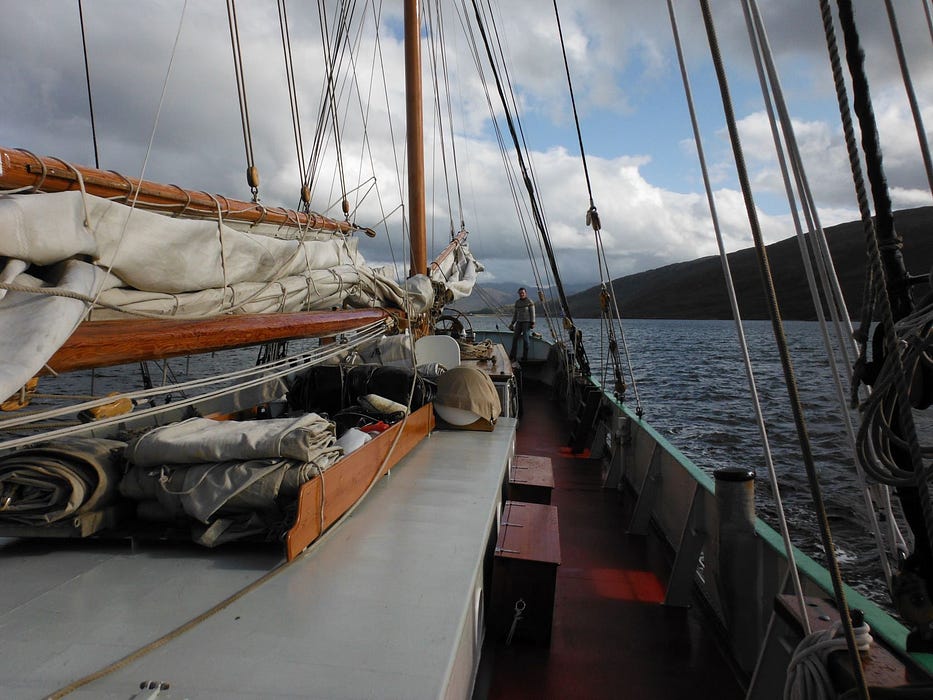
To set the four lower sails on Tecla, we began with hoisting the largest sail, the main sail. Two hefty wooden spars embrace the tall wooden mast. The spar at the bottom of the sail is the boom. The spar on top that holds up and out the sail is called the gaft. Two rope lines (halyards) are pulled to raise the main sail. One halyard is attached to the throat of the gaft where it meets the mast. The other halyard is attached to the outer end of the spar, called the peak because it will be the highest point of the sail. To raise the main sail, three or four people stood at the throat halyard on one side of the mast, and three or four on the other side at the peak halyard. The captain watches the raising of the sail to keep the gaft level moving up the mast. Then to finish, the peak is raised until the sail is smooth.
The mizzen sail is smaller than the main sail. It is in back of the main sail making this tall ship a ketch and not a schooner where the mizzen is before the mast. The mizzen has the same gaft rig and halyards as the main sail. The triangular sails in the front of the vessel, the staysail and jib. They are relatively easier to hoist being shanked onto metal stays with bronze clips. However, the jib and staysaill have more complicated lines to handle with outhauls, downhauls, sheets, and others to help bring the sail from one side of the vessel to the other.
The first rule is to never loosen a line until you are certain of its function and then it is better to ease it while still wrapped around the belaying pin. We work slowly; one sail at a time. It can only be done by people working in synchrony, mindful of where everyone is standing and where fingers are placed. When making fast the line, the knot must be perfect with maximum friction of line on line. Tied so that it can be swiftly undone. Lastly, all of the many lines are coiled and hung so that they are off the deck.
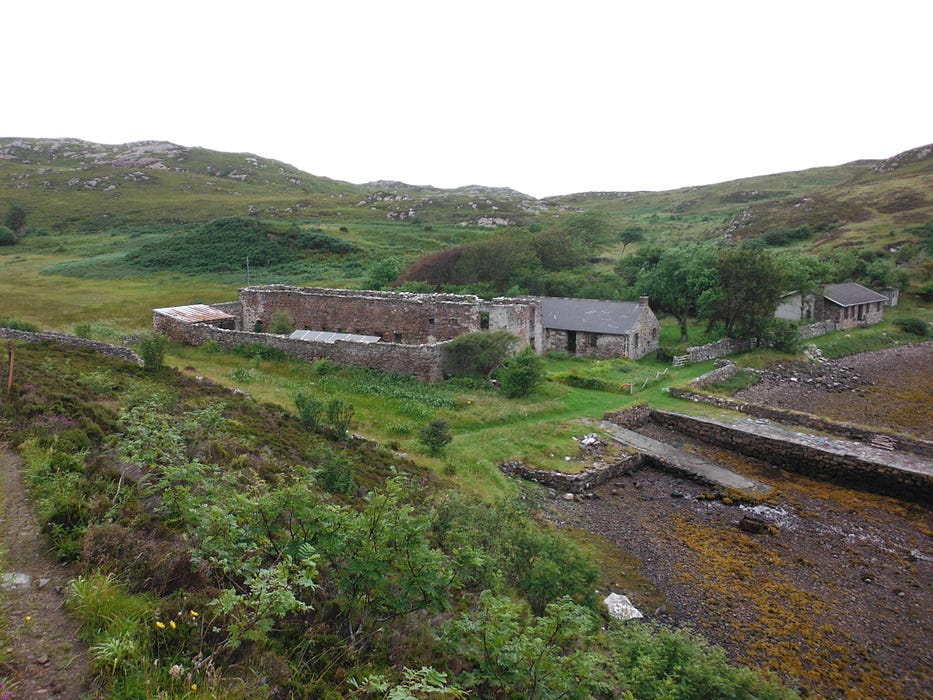
Sailing down Loch Broom we pass the Summer Isles. The largest island is Tanera Mor with a farm once worked by Frank Fraser Darling with his wife and young son. His book, Island Farm, makes clear how difficult farming was. The stoic farm has been let go, gone back to nature with some buildings in need of repair and others looking not occupied.
The solitude and struggles of farming in the Hebrides had an impact on Fraser Darling. As did the people working the land, the crofters. With government funding, he employed Gaelic-speaking researchers to interview crofters across the Highlands and Hebrides. The result was the West Highland Survey, an essay in human ecology. Combining social science with natural science, he contended that a modern capitalistic society with deforestation, the concept of private property, and a market economy had disrupted ecological balances and caused “a devastated countryside.”
Published in 1969, Fraser Darling’s book Wilderness and Plenty was an awakening of responsible stewardship of the land that helped to launch the environmental movement. For Fraser Darling, if not for the planet, the Hebrides were a crucible.
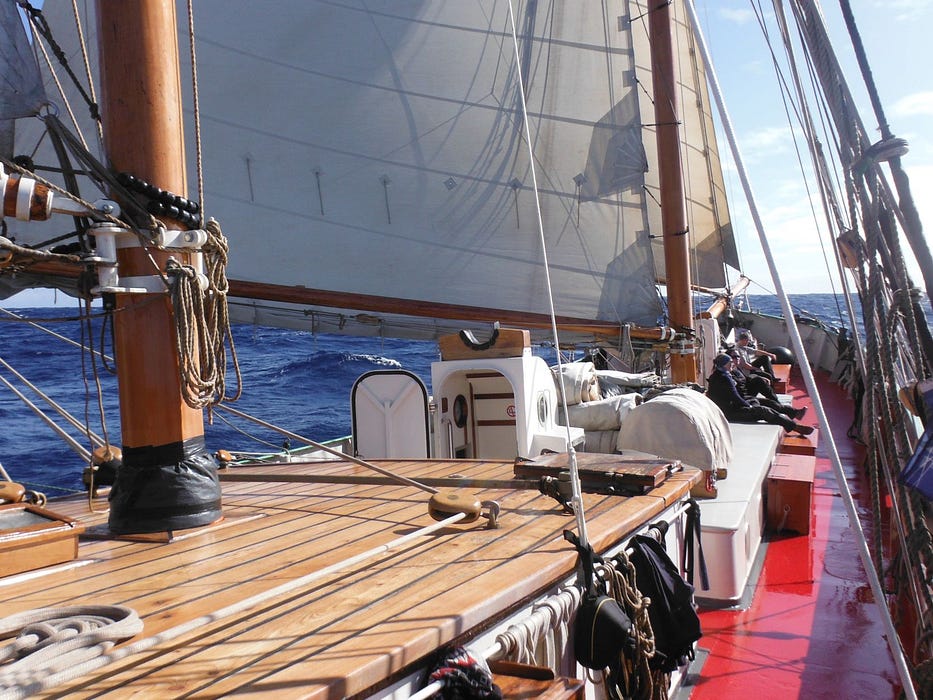
We carry on. The sailboat, Tecla, clears the loch and turns down wind with sails swung out for a broad reach into the Minch. We are encircled as if in a stadium with steeply sloping green isles of the Hebrides and the craggy shores of the Northwestern Scotland. Mountains loom beyond. High on an island, silhouetted against the sky, stands a white-tailed eagle nearly four feet high. White-tailed eagles have been successfully reintroduced to Scotland.
The sea is quite flat, sheltered from the high swells of the North Atlantic. With winds 15 to 25 miles per hour, these are world’s best conditions for voyaging as Tecla speeds on at 9 knots (nautical miles per hour or about 11 mph).
The Hebrides were known to ancient Greeks as the Hyperborean World beyond the white cliffs where the light never dies. Apollo, the sun god, was believed to have been born in both Crete and in this Hyperborean World.
We’re traveling from the northern terminus of the Atlantic Arc. Herman Melville sailed to Tenerife in 1837. In his third book, Mardi, and a Voyage Thither, the narrator is accompanied by a very capable Hibernian “aboriginal tar.” Because he comes from the Isle of Skye, Melville calls him “Skyeman.”
More light from the Hebrides, Celtic Christians tell of Bridget traveling the Atlantic Arc and beyond to Bethlehem where she worked at the inn, perhaps as a barmaid, that Mary and Joseph came to on a dark winter’s night. They say Bridget was the midwife for the birthing of one who is believed to be the son of light.
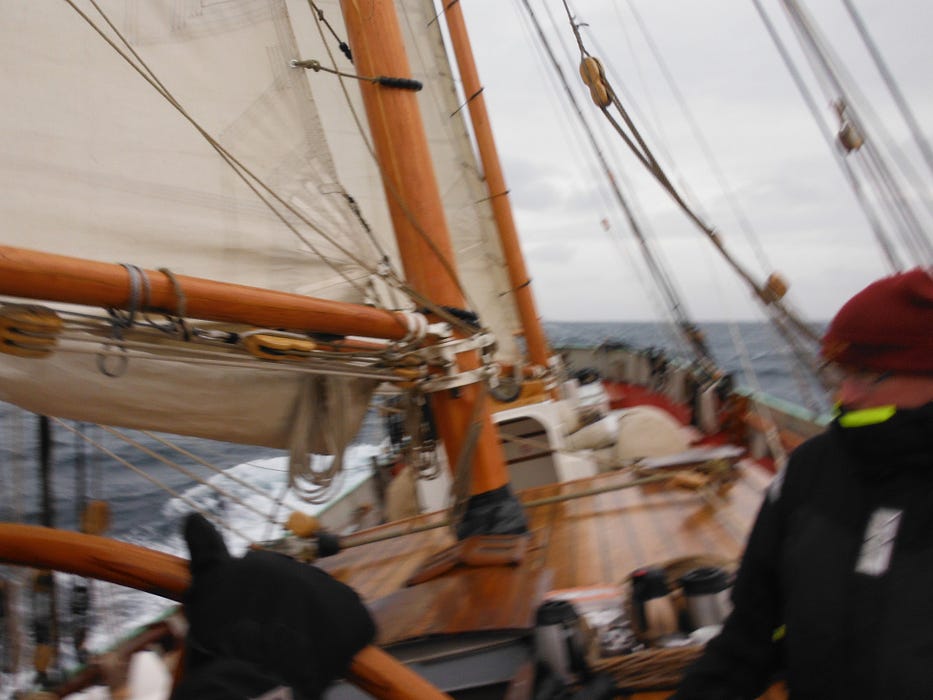
On a starboard tack with left railing down, we pass the sandy isle of Iona that was low before the mountainous isle of Mull. In 563, Columba traveled to Iona with twelve men in a wicker and leather boat called a currach. Strategically located in the Atlantic Arc, Iona was a beacon of learning and literacy.
Far across the blue waters gannets flash white. These are large seabirds, all white except for black wingtips with long pointy bill and tail and straight wings. They look like flying crosses. Gannets plunge dive straight into the water. They are working a school of fish. Suddenly a minke whale surfaces and lunges horizontally into the feeding foray.
Offshore, beyond the realm of gulls, the only seabirds that take notice of us are fulmars. They are grey and white birds related to the albatross with a pair of tubes on their bill like nostrils to secrete salt, are. Fulmars will fly in obliquely and circle the ship. I look for fulmars and welcome the company of another life. Their white faces with black eyes look serene, even when with outstretched wings they bank steeply in a turn wing tip nearly scoring the water. They seem to enjoy riding the drafts off waves up and down.
Leaving the Minch, the island of Mingulay receded behind us with towering black basalt cliffs, sweeping green swale, topped with a gleaming white lighthouse. A brown chunkier bird, a great skua, flew by darkly appearing intent on a Southwesterly destination where there is no land. In the Hebrides skua are called bonxie. We sailed off the continental shelf over waters more than 5,000 feet deep and out into the Atlantic. Intrepid Tecla became a tiny speck of humanity in an immense unforgiving ocean.
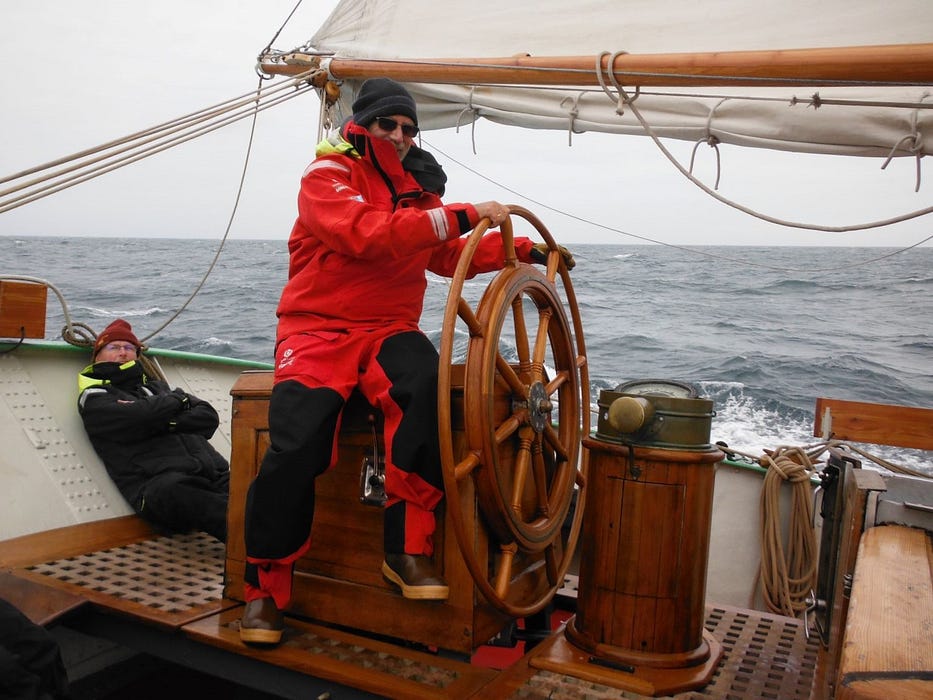
I stood watch from 4 to 8, morning and night, or was it night and afternoon. We fell into a timeless rhythm of rise, stand, recharge and do it again. Standing with me on watch were a South African and a Dutchman working for the European Union living in Brussels. At 3:40 in the morning my alarm went off. I pulled on Smartwool long underwear, a thick Orkney wool sweater, foul weather gear (bought used on EBay) and Xtratuf rubber boots from Alaska. On deck it was pitch black. Stepping through the bulkhead portal doorway onto the deck, we felt our way around the cabin top to the back of the ship where the binnacle holding the compass glowed. Figures were outlined in the soft light. Gradually, over the course of twenty minutes, our eyes adjusted to see dark ship, sea, and sky.
One of the members of the watch would tell us the story of the watch. This included report on the weather, set of the sails, what compass courses were steered, what ships had been seen and what ships were about. Any wildlife sightings were also shared. Relieving the watch, the person steering would state the compass course. This would be repeated by the next helmsman. We thanked the off-going watch and wished them well.
The was only once of a discordant word between the three of us on watch. One complained that another was too exuberant to take the wheel. When asked who wanted to steer, he was often first to volunteer. We would steer for a half hour and then change. The trouble was with a four-hour watch that rotation resulted in two having three tricks at the wheel and one having only two. We resolved it by asking the one concerned to keep track of whose turn it was to be first at the wheel. I like sailing with people whose biggest complaint is insufficient time at the wheel.
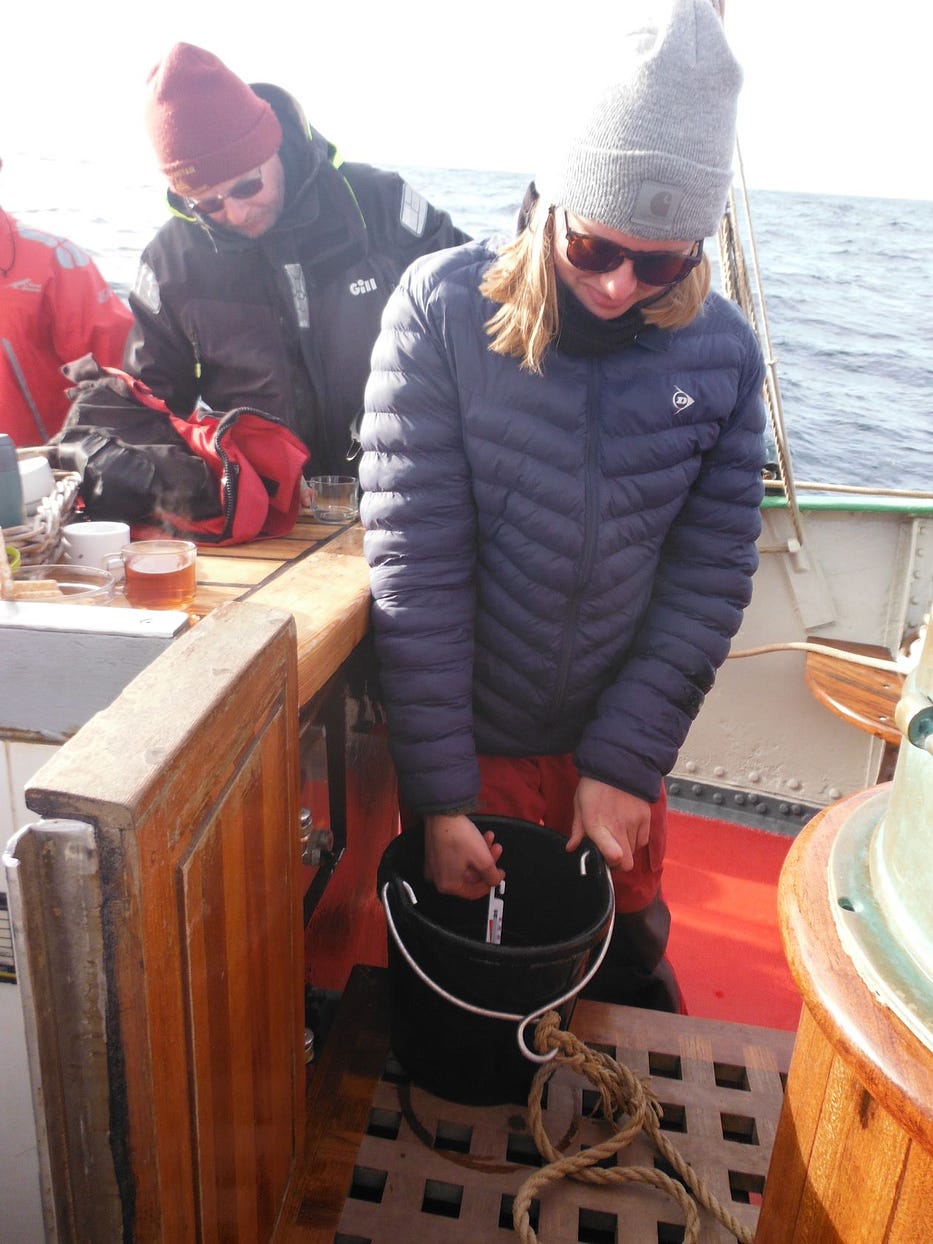
On our watch, the deckhand prepared to take the temperature of the seawater. We were asked to guess what the temperature would be as we barreled along southwards. She threw the bucket on a rope into a passing wave and pulled it up over the railing. A thermometer was held in the seawater for a while. The temperature was proclaimed and recorded. Often the daily rise was about half a degree Celsius.
At 6 am the first mate and deckhand were relieved by the captain and other deckhand. Just before 6, the first mate would bring up a big steaming pot of oatmeal porridge. The seven us would stand around in the dark eating oatmeal. Then the mate and deckhand stood down. They would have six hours off and then go on watch at noon.
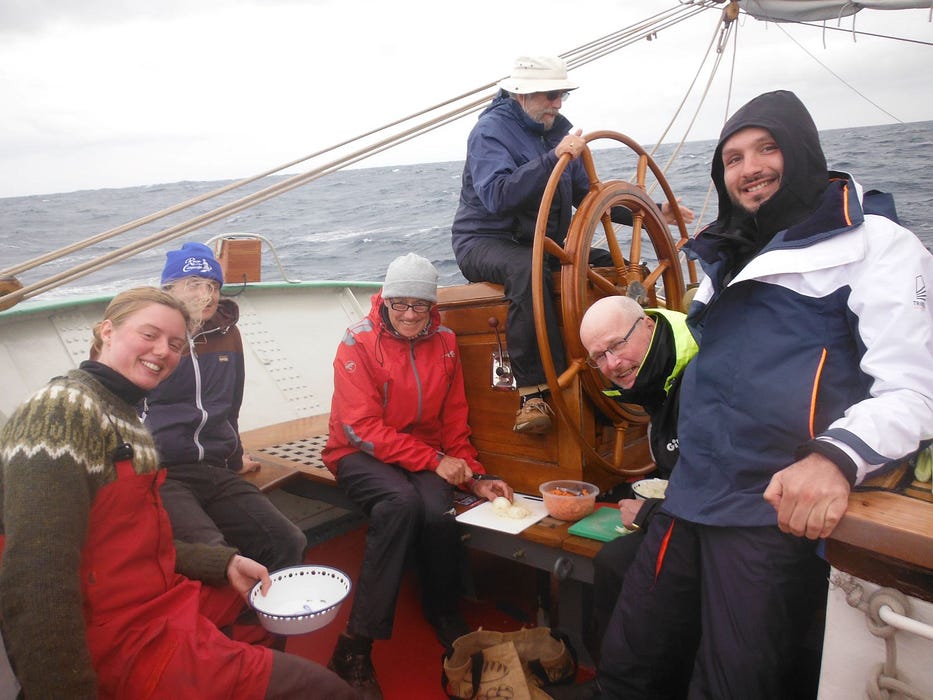
In the late afternoon, the captain spent time in the galley cooking dinner. After 4 pm the deckhand on watch brought up vegetables that needed cutting and chopping. On watch, if not steering, we chopped and peeled on cutting boards next to the steering box at the foot of the helmsman. When dinner was ready, the captain and deckhand would take over the steering and sent us below. We filed in along two tables with couches against opposing walls. Rubber mats beneath the dishes kept all in place, most of the time. Food was set in large dishes in the middle of each table. It was either passed around or, when there was a big pot or deep dish, plates were passed towards the middle. The deckhand on watch would stop by for two plates. The captain often ate straddling the steering box with wheel before her and plate of food between her legs. For her, the ship needed little steering, or so she made it seem.
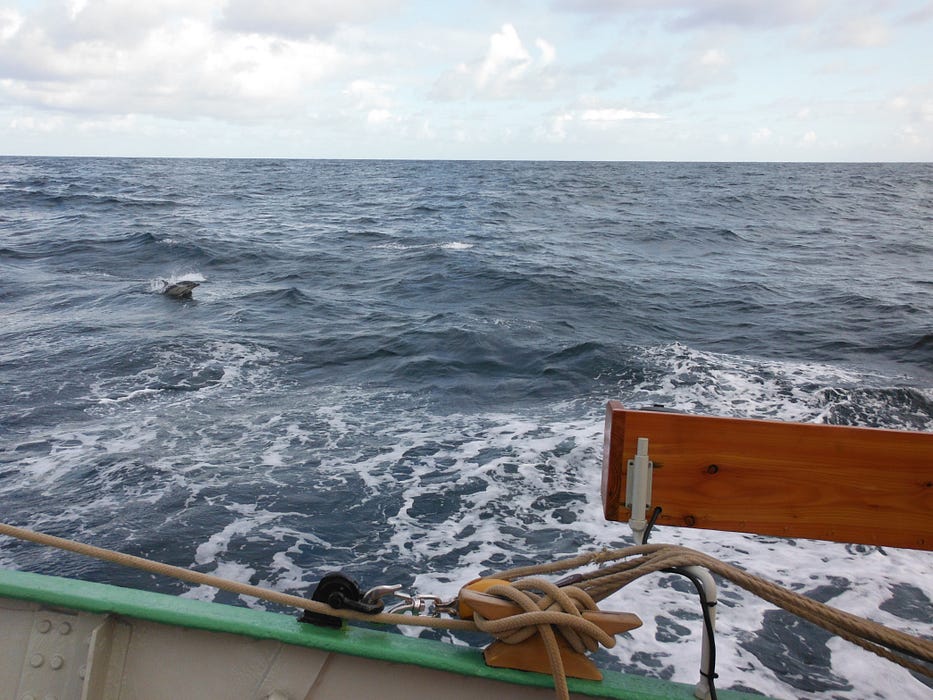
The midnight watch saw dolphins riding the ship’s bow wave with pale green light streaming like hair. One could understand why sailors might see mermaids.
At night, with the Milky Way overhead and the constellation Orion hunting high, there appeared to be more life in the sea around our vessel than are stars in the sky. We tossed a bucket into the sea and pulled up black water. Stirring the water with one’s hand, flashes of light sparked in the bucket. There was life here that was invisible.
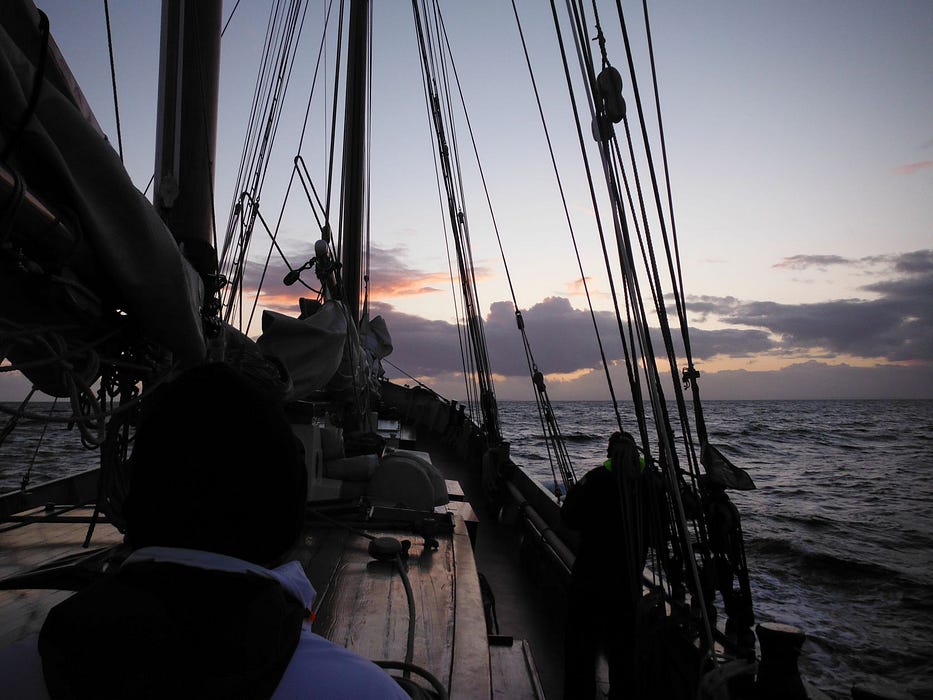
At first light, the deck hand and I went forward to take down the Scottish flag and replace it with the flag of Portugal. We were far off the Bay of Biscay, 600 plus miles, and heading towards the Portuguese Islands of Madeira. The squish sound under his bare foot was a squid. In the night, squid leapt out of the water to travel faster presumably away from predators. This squid had cleared the six feet of the ship’s vertical sideboard, up and over rail, and onto the deck.
I touched the squid’s five-inch mantle. It was slippery. I managed to take hold and raise it tail high for the captain to see. She bid me to quickly toss the head-and-tentacle-dangling cephalopod overboard. Clearly, there would be no calamari served on this voyage. When the next watch relieved us, they were excited to hear of the squid and disappointed not to see it.
The next dawn revealed eight squid on deck. One squid had released black sepia ink. I placed one squid in the bucket. When the story of the watch was told there was reference to a finding in the bucket. After examination in the bucket, a squid hunt followed. A nineth squid was found in the afternoon in the docking lines by one who had regretted missing the morning hunt. He reported that squid was particularly stinky. Perhaps it had come aboard a day earlier.
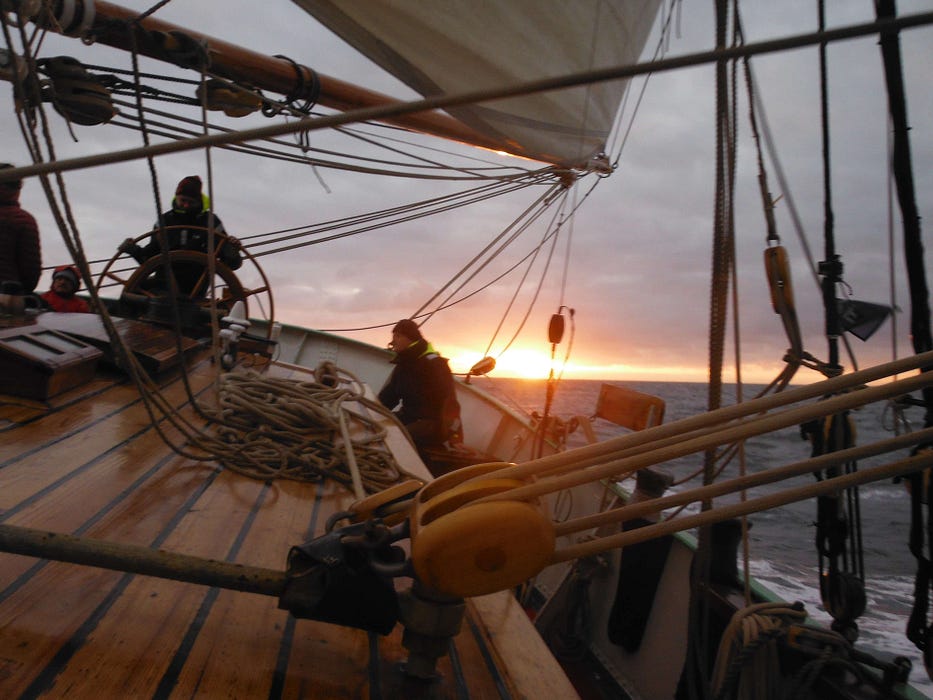 I had the good fortune to glimpse a sea turtle the size of a dinner plate gulp air and then settle into white-capped waves as our sailing ship sped along. Sea turtles are crucial to the health of ocean ecosystems. One turtle sighted during eleven days and 2200 miles at sea may not seem like a lot of turtles. Nonetheless, that little turtle in a tempest gave me hope for both sea turtles and the ocean.
I had the good fortune to glimpse a sea turtle the size of a dinner plate gulp air and then settle into white-capped waves as our sailing ship sped along. Sea turtles are crucial to the health of ocean ecosystems. One turtle sighted during eleven days and 2200 miles at sea may not seem like a lot of turtles. Nonetheless, that little turtle in a tempest gave me hope for both sea turtles and the ocean.
Night and day, we all took turns watching the compass rose swing inside the binnacle and steering with hands on the spokes of the wheel. Winds from the northwest were gusting up to 25 mph. The mainsail and mizzen sail were shortened, reefed, to present less surface area for the wind. Still, the ship sped along as fast as hull length and displacement, the hull speed, would permit.
Large swells from the West buffeted and pushed the ship further over onto its left side. At times a swell would pick up the back of the ship turning it to the windward. The Helmsman responded with many turns of the wheel to bring the ship back on course. Turning the wheel one way than the other; skillfully bringing it back on course.
One time when I was at the wheel, a rolling swell pushed the front of the ship so hard to the left that I thought of a football player grabbing the ship’s front, the jib boom, and running perpendicular with it, oblivious to my turns of the wheel.
From the Northwest, like from Newfoundland across the Atlantic, came enormous waves, eight to sixteen feet in height. Some said twenty feet. There was much discussion on how to measure wave heights on a rolling and rocking ship where it is impossible to tell what level is. I tried to sight the water level in a raised plastic bottle, but the water inside sloshed about more like a clothes washer than a level.
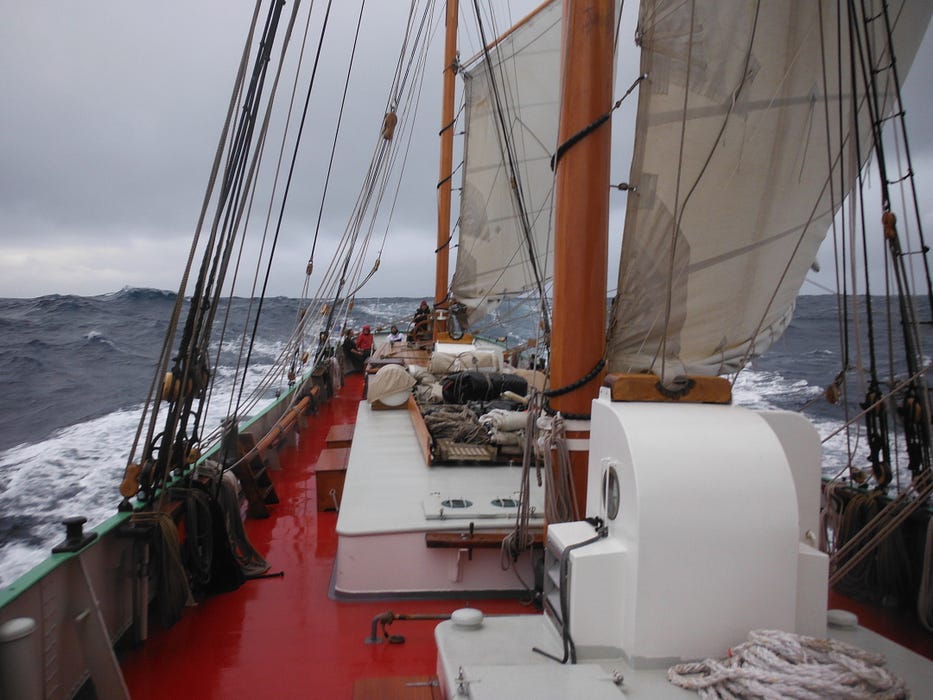
Wave loomed up behind us and threatened to tumble into the ship. The back of the ship rose up. The wave passed below. The front pitched downwards, and the ship sped up surfing the wave to possibly 12 knots (14 mph), more often 10–11 knots. The front of the ship pitched upwards, slowed it speed on the backside of a frosted wind-blown wave. The process repeated to varying degrees as the ship rocking-horsed and cork-screwed over the waves.
Squeezing my legs together into the wooden sides, I straddled the steering gear box behind the wheel and wished for stirrups to maintain my seat on the bucking ship. About a third of us were seasick during those seven days of really swell passage.
With Force 4, 25 miles per hours winds from the West, we stayed far away from Ireland’s rocky shore, at least 500 miles. I both regretted and was relieved not to see the stony parapets of an inhospitable shore that lay in the direction that strong winds and waves were pushing us.
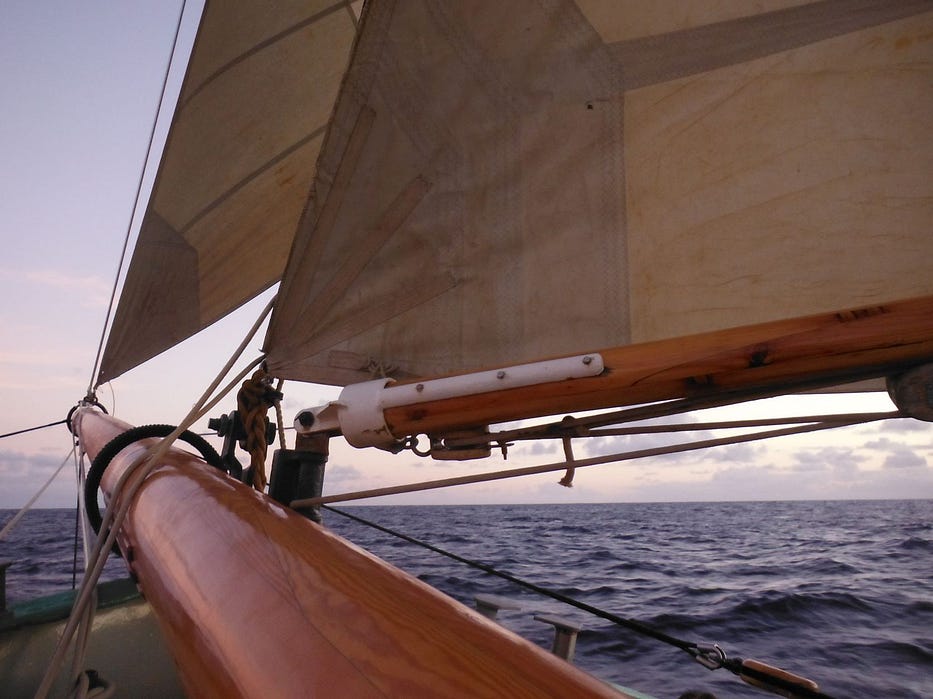
Sailing blue water is rewarding and fulfilling on many levels. There is a complete departure from the daily hubbub of clock watching doing everything on time according to regimented expectations. Moments before the ship had left the dock, I had turned off and stowed my cellphone. With that act, the outside world ceased to exist. There was no internet, no emails, no social media, no news radio or even word of mouth. We entered a timeless world of watch rotation, four hours on and eight hours off. I quickly lost track of what day of the week it was and had not reason to care. We were completely focused on sailing the ship, the elements and the welfare of each other.
Life on ship is very intimate. Passages and spaces are small so one cannot fall far. The stairs are steep, ten degrees angle short of a ladder. We take turns moving about and are gracious about who goes first. There is never any rushing. Movements are deliberate. Everyone quick to say sorry with every touch and thank you with every gesture.
In my bunk I was completely in tune with the ship. When the engine stopped, I knew sails were being raised and rushed out of my slumber to lend a hand.
Stepping over a portal’s high threshold, out onto the deck, the expansiveness all about is so immense that one might think of an astronaut taking a walk into outer space. Waves rise and recede to distant horizons in all directions. One day, the chaotic waves gave the impression of being on top of an unruly head of hair with waves waving every which way.
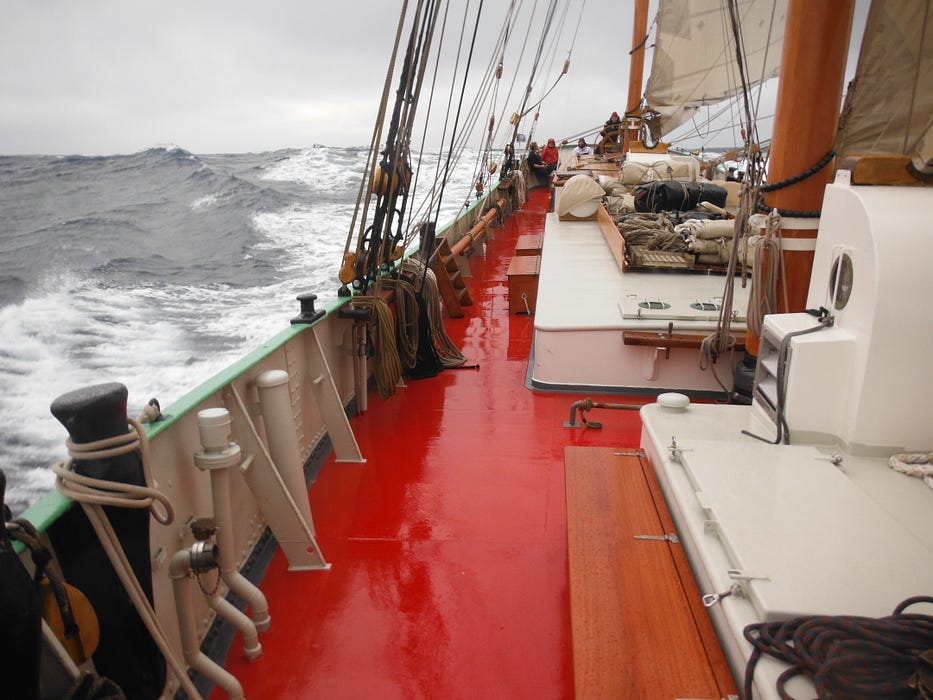
It is bracing in so many ways. Our tall ship is so very small in an immense seascape. We hunker down between waves and then rise high to see great droves of rushing waves. As a wave crests, the wind flicks white spray back. The wall breaks to tumble forward and streak white down its face. “All the white horses, far from shore”, sing the McCallums.
Constantly alert, we crossed the rowdy furrows. We work in concert to use the power of the wind to gain our destination. The course is constantly adjusted as the wind slightly backs counterclockwise or veers clockwise. We are careful to never to have the wind directly behind the boat. With sails and spars all on one side, we do not want the wind to come from the other side and wrench all of that to the other side. We must not jibe. Instead, we go one way, closer to the wind direction, and then days later change course to go the other way nearly perpendicular to last course.
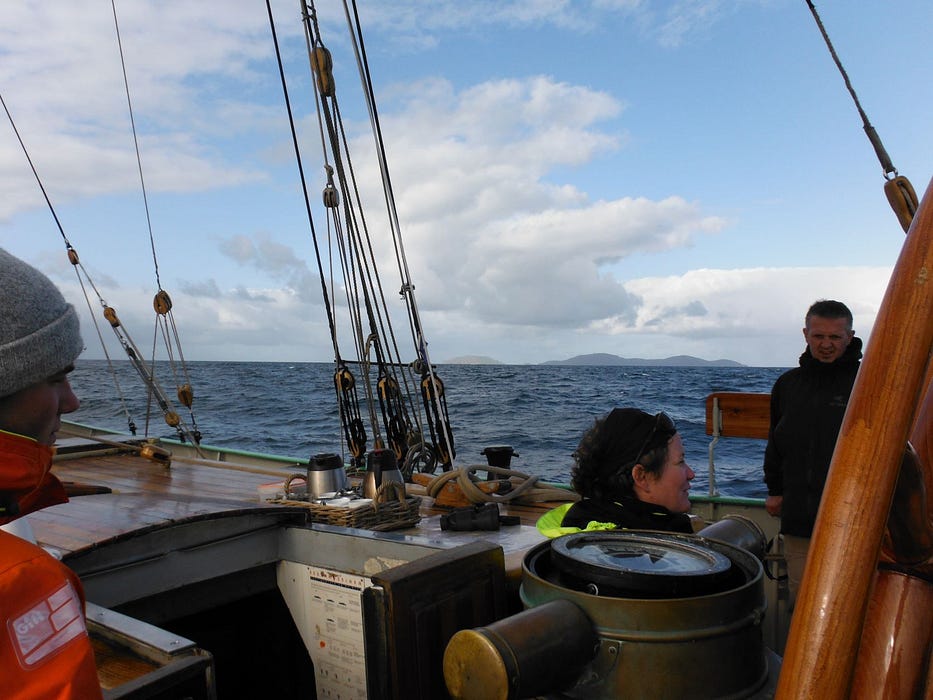
Finally, after seven days and more than 600 miles West of Portugal, the ocean swells quieted, the rocking-horse motion ceased, and we rolled along more evenly. These were the best sailing conditions for the Atlantic Arc one could ask for. In one day, we sped 212 nautical miles (244 miles) and all days were better than 140 nautical miles (161 miles). Our average speed was 7.3 knots. Making such good time, we were ahead of schedule and had time to stop in the Madeira Islands.
On the nineth day out of Ullapool, a dark bird made broad sweeping circles with wings straighter than a gull and longer than a fulmar. It was shearwater larger than the Manx shearwaters we had seen in the north. It seemed to me to be the size of the Cory shearwaters that we see in July feeding on Stellwagen Bank East of Boston. It was a Scopoli shearwater that nests in the Madeira Islands.
Later that day we reached Porto Santo one of the Madeira Islands and tied up to the quay. Going ashore the land felt like it was moving, shifting gravity. That feeling I expected. I did not expect to feel, lying in my bunk, the rocking and rolling motion of sailing when I knew the ship was secure to the quay.
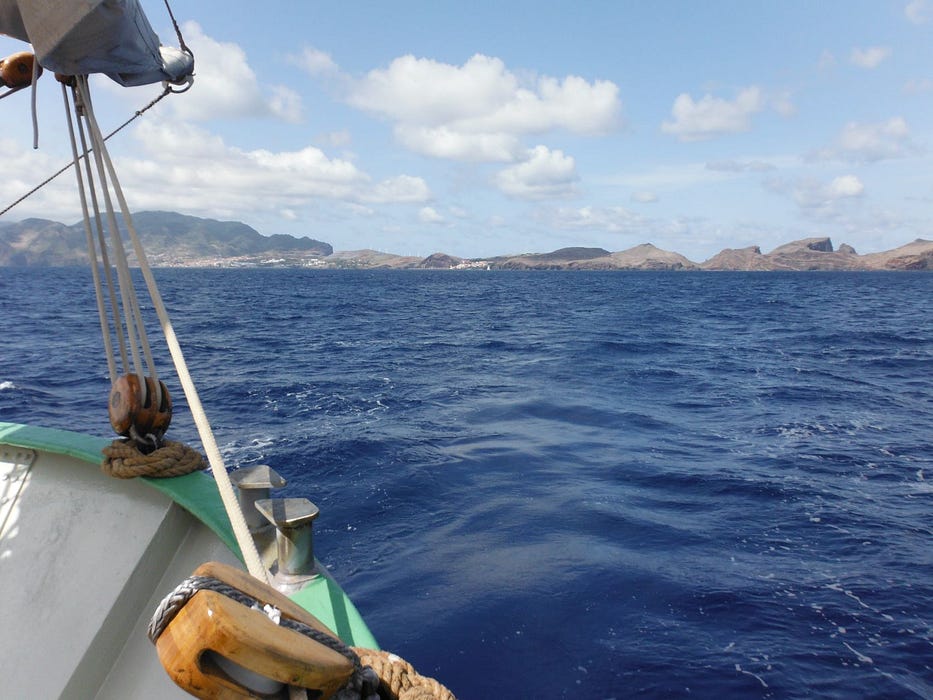
We departed three days later for a mere 46-hour sail to the beautiful Spanish city of Santa Cruz on Tenerife in the Canary Islands. We had sailed 1987 nautical miles (2,287 miles) from Ullapool. There, I and most of us left the ship to return home. In a few days, Tecla was scheduled to sail 54 days to the Falkland Islands.
We sailed with a compliment of twelve individuals hailing from six nations. Here, Melville’s fellowship of the foredeck was well met with “the nations and families, flocks and fields of the earth, one and all, brothers in essence?—?oh, be we brothers indeed!”
Melville wrote Mardi during the Mexican American War, a war of American aggression that Mexico never declared. He saw that sailors knew how to work well together and depend on each other despite their differences. If all men were sailors, those conscripted to serve in the military would refuse to follow commands to kill because “we be brothers.”
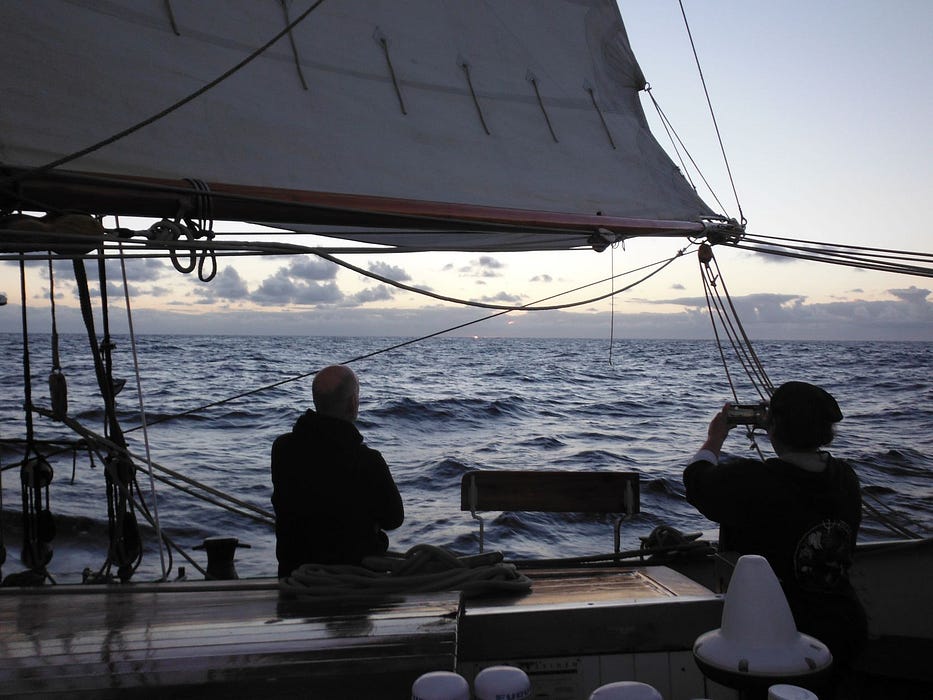
Today, the war is against climate change to slow the warming of the planet. To succeed we respect the competencies of others and lend a hand into the fray. A leader does us a disservice when he says: “It will take each and every one of us fighting in the trenches each and every day.”
Many hear this as a call to go it alone and fight those close at hand. There is much Monday-morning quarterbacking and laying of blame. These people choose to make to make lifestyle changes as their part in the fight and then demand others to do it their way. It is counterproductive to think one better than others and lonely. Unable to change others, frustration may metastasize into despair.
Better is the call to join a crew like that on a sailing ship where we all depend on each other, and not on advanced technologies in black boxes. When its time, relieve the others on deck, take heed of the telling of the watch story, and stand steadfast in the knowledge that a time will come when the watch is over.
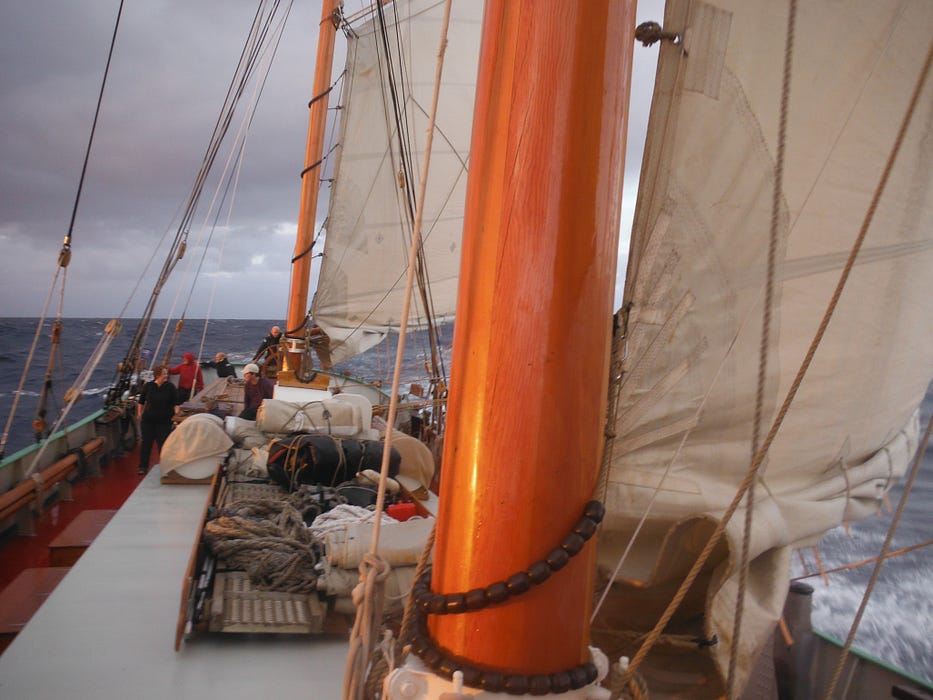
Beneath lowering skies, the addressing-climate-change voyage is underway. We mark progress, take the measure, adjust course, and carry-on reducing carbon emissions and increasing carbon drawdown, ton by ton. We steer for Net Zero where emissions equal carbon drawdown. The destination is beyond, to restore nature so there will be more carbon dioxide taken-up than emitted. With 800 billion tons of carbon in the global atmosphere, 100 billion tons needs to be manufactured by plants into carbohydrates put back into nature to go the distance restoring ecosystems, water cycles, and the health of the planet.
There will be the unexpected, the rogue waves and fierce squalls knocking the ship off course?—?count on it. You will get wet and may get seasick. We take the time that is needed to bring the ship back on course and forward on our way. We dress for the weather, go on deck on time to relieve the watch, survey the deck, sea and sky, take the helm, and with a cheer, carry on.
It is during these extraordinary voyages that we are most alive and most “one and all.” We hope it will never end and are sorry when the voyage is done to go our separate ways.
The Ocean River Institute provides opportunities to make a difference and go the distance for savvy stewardship of a greener and bluer planet Earth. www.oceanriver.org
source http://www.expertclick.com/NewsRelease/Sailing-into-the-light-of-a-healthier-and-more-humaneplanet,2022279866.aspx
Comments
Post a Comment